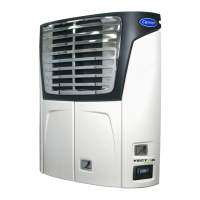62-11785 5–20
NOTES
1. If a Data Transfer USB memory device will be used to setup the remainder of the main microprocessor set-
tings, proceed to Section 5.5.7 after the settings are entered.
2. After the unit specific and time sensitive configuration settings are complete use the UP or DOWN ARROW
keys until “CONFIGS COMPLETE, = TO EXIT” is displayed in the MessageCenter. Press the ”=” key to
save.
3. If the Configurations, Functional Parameters and DataLink data recorder setup will be set using the display
mounted keys and/or TRU-Tech, continue with following steps.
5.5.4 Configurations Using Display Mounted Keys
Refer to Table 5–1 for a list of available Configurations. Refer to Section 5.2.3 for instructions on how to access
them.
5.5.5 Functional Parameters Via Display Mounted Keys
1. Refer to Table 3–2 for a list of available Functional Parameters and Section 3.17 for directions on how to
access them.
2. Leave the system powered up as you continue with the next section.
5.5.6 DataLink Data Recorder Via TRU-Tech
If the factory settings are used, this section can be skipped.
1. Refer to Section 3.10 for list of DataLink data recorder setups.
2. Connect a computer to the USB interface port of the unit and start the TRU-Tech program (refer to Section
5.4).
3. In TRU-Tech, click on the REEFER SETUP LIVE/Data Recorder Tab.
4. Select the Sensors to be recorded and then select averaged or snapshot recordings (averaged is recom-
mended/default for RAT, SAT, AAT and the remote sensors; snapshot is recommended/default for all oth-
ers).
5. When the setup is correct, press the Send button to send the new settings to the system.
6. From the “Confirm Send Information” Pop Up, check the data that is to be sent and un-check the data that is not
to be sent. Click the OK button.
7. Verify that the settings were sent by waiting for the confirmation pop up message.
If the DataLink data recorder date and time were not set earlier, they can be set from TRU-Tech.
5.5.7 System Final Checkout
1. Start the unit and allow it to run for a few minutes.
2. While the unit is running, scroll through the Data List. Verify that all the data is now accurately displayed.
3. Initiate a Pretrip test. Allow the unit to complete the Pretrip and check for any alarms. Make any necessary
repairs before returning the unit into service.

